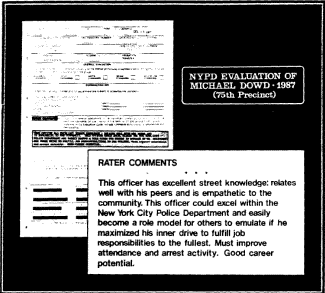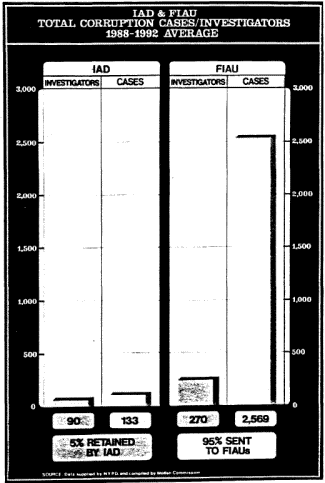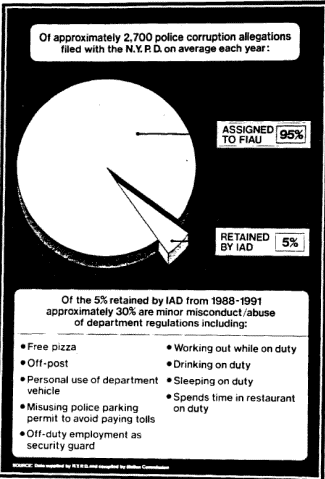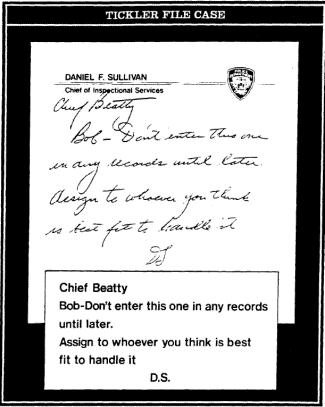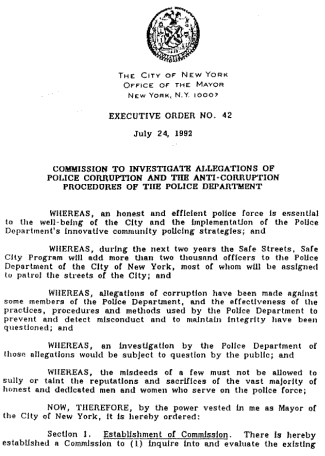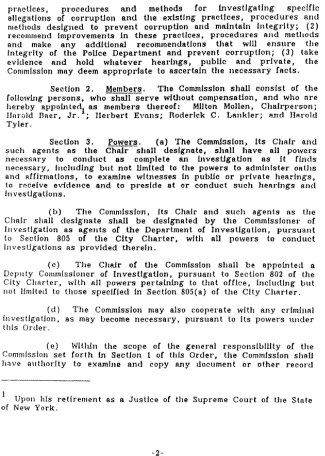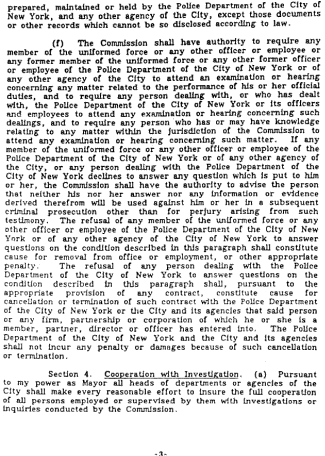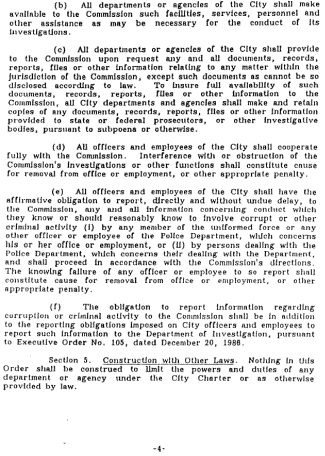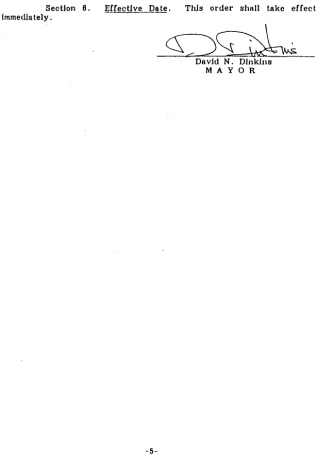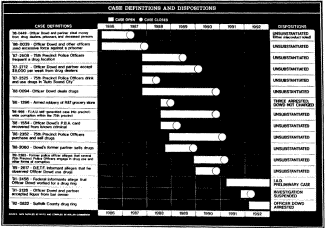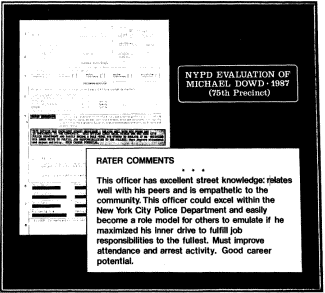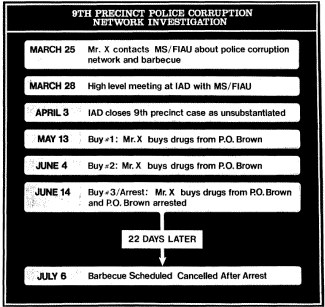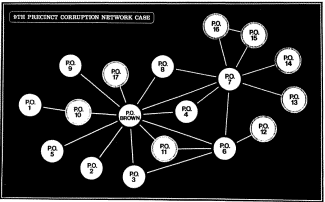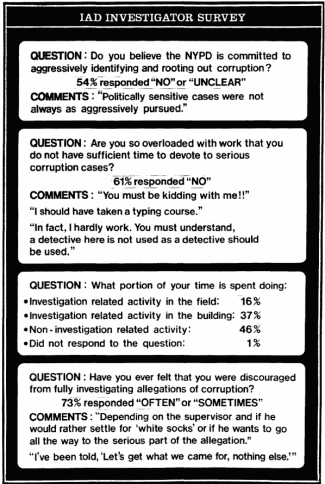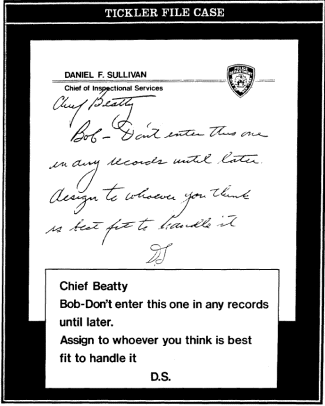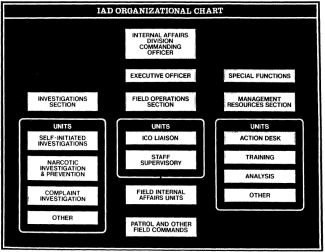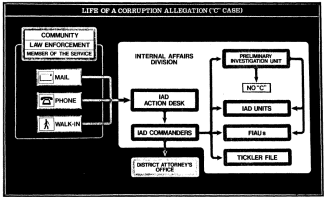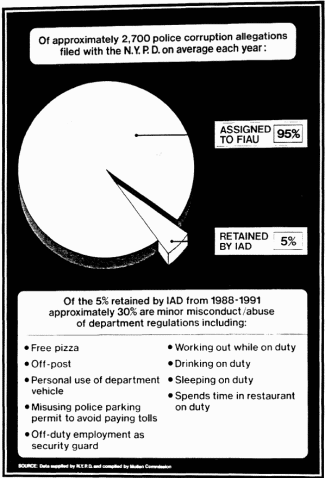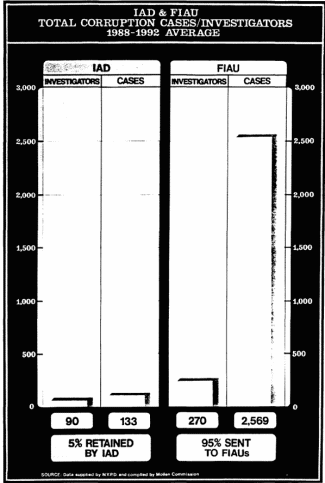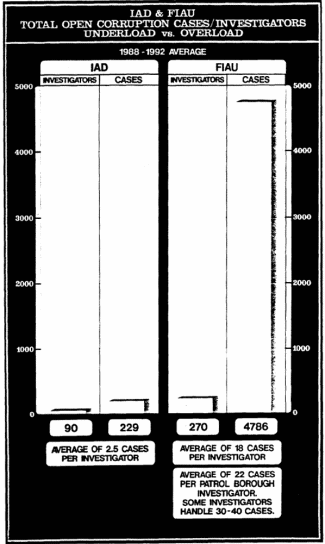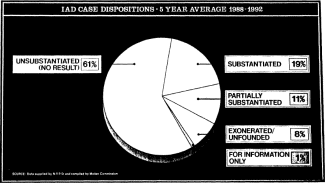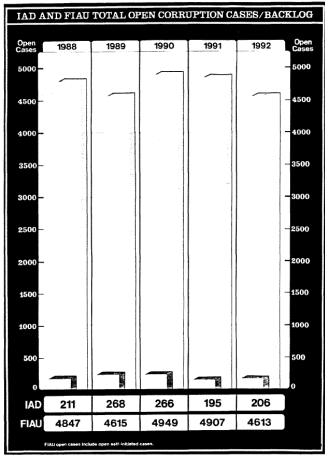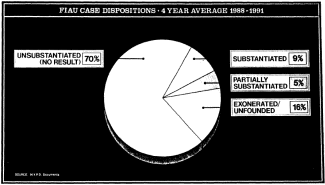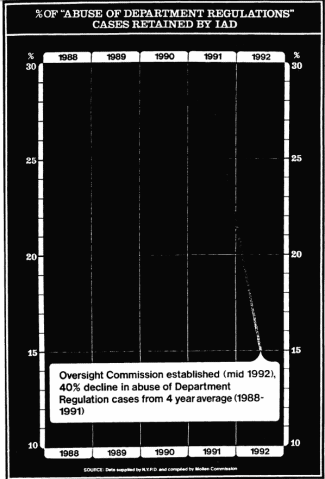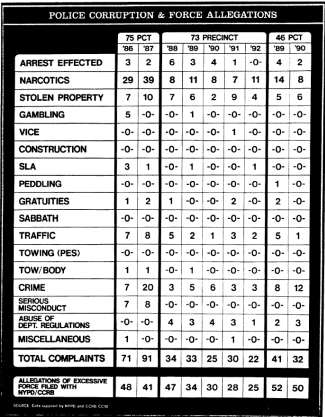"We must create an atmosphere in which the dishonest officer fears the honest one, and not the other way around."
-- Detective Frank Serpico, Testifying before the Knapp Commission, December 1971
More than twenty years after Frank Serpico's testimony, this Commission found that the dishonest officers in the New York City Police Department still do not fear their honest colleagues. And for good reason. The vast majority of honest officers still protect the minority of corrupt officers through a code of silence few dare to break. The Knapp Commission predicted that the impact of their revelations would significantly weaken the characteristics of police culture that foster corruption. In particular, they hoped that their success in persuading a number of corrupt police officers to testify publicly about corruption would forever undermine the code of silence, the unwritten rule that an officer never incriminates a fellow officer. Unfortunately, their hope never became reality.
Police culture -- the attitudes and values that shape officers' behavior -- is a critical component of the problem of police corruption today. This Commission, therefore, was not satisfied simply to examine the types of police corruption we found to exist. The more difficult question we asked is why such corruption exists, what are the root causes and prevailing conditions that nurture and protect it, and how they can be effectively addressed. Only by examining the variety of influences and attitudes that contribute to corruption, can we assess and formulate strategies to stop it.
The code of silence and other attitudes of police officers that existed at the time of the Knapp Commission continue to nurture police corruption and impede efforts at corruption control. Scores of officers of every rank told the Commission that the code of silence pervades the Department and influences the vast majority of honest and corrupt officers alike. Although police officers who look the other way while colleagues steal property, sell drugs, or abuse citizens' civil rights may not be directly involved in corruption, they nonetheless support and perpetuate it by abandoning their professional obligations.
These aspects of police culture facilitate corruption primarily in two ways. First, they encourage corruption by setting a standard that nothing is more important than the unswerving loyalty of officers to one another -- not even stopping the most serious forms of corruption. This emboldens corrupt cops and those susceptible to corruption. Second, these attitudes thwart efforts to control corruption. They lead officers to protect or cover up for others' crimes -- even crimes of which they heartily disapprove. They lead to officers flooding Department radio channels with warnings when Internal Affairs investigators appear at precincts, and refusing to provide information about serious corruption in their commands. Changing these aspects of police culture must be a central task if corruption controls are ever to succeed.
The realities of police work bolster these corruptive features of police culture. As a society, we expect more of police officers than any other public servants. We call upon them daily to accomplish a variety of competing responsibilities. We expect them to be daring crime fighters as well as patient mediators. We call upon them to stop crime in our neighborhoods, to resolve our domestic disputes, and to act as obedient members of a paramilitary organization. Most of all, we expect them to confront physical danger and risk their lives to protect our lives and property. After a time, particularly in high-crime areas, they begin to identify the criminals they must confront every day with the community they must serve. They begin to close ranks against what they perceive as a hostile environment. Consequently, many officers lose sight of the majority of law-abiding citizens who live in their precincts. When this happens, corruption becomes easier to commit and to tolerate.
Citizens often return this hostility. With crime, drugs, and guns rampant in parts of our City, the public incorrectly faults the police. When incidents of police corruption are disclosed, the community incorrectly assumes that this is the norm. When police officers interfere with citizens' activities, the public often resents it. Police officers feel this resentment. What the Knapp Commission observed in its time is just as applicable today:
Nobody, whether a burglar or a Sunday motorist, likes to have his activities interfered with. As a result most citizens, at one time or another, regard the police with varying degrees of hostility. The policeman feels, and naturally often returns, the hostility. [8]
Faced with this resentment, the dangers of their work, and their dependence on other officers for their mutual safety, police officers naturally band together. Often to such a degree that officers become isolated from the outside world. They socialize with and depend upon fellow officers not only on the job, but off. An intense group loyalty, fostered by shared experiences and the need to rely on each other in times of crisis, emerges as a predominant ethic of police culture.
This loyalty ethic itself is not corruptive. Loyalty and trust are vital attributes that promote effective and safe policing. We cannot ask police officers to abandon their loyalty to each other while simultaneously demanding that they confront danger for us.
But group loyalty often flourishes at the expense of an officer's sworn duty. It makes allegiance to fellow officers -- even corrupt ones -- more important than allegiance to the Department and the community. When this happens, loyalty itself becomes corrupt and erects the strongest barriers to corruption control: the code of silence and the "Us vs. Them" mentality.
The Code of Silence
The pervasiveness of the code of silence is itself alarming. But what we found particularly troubling is that it often appears to be strongest where corruption is most frequent. This is because the loyalty ethic is particularly powerful in crime-ridden precincts where officers most depend upon each other for their safety each day -- and where fear and alienation from the community are most rampant. Thus, the code of silence influences honest officers in the very precincts where their assistance is needed most.
The pervasiveness of the code of silence is bolstered by the grave consequences for violating it: Officers who report misconduct are ostracized and harassed; become targets of complaints and even physical threats; and are made to fear that they will be left alone on the streets in a time of crisis. This draconian enforcement of the code of silence fuels corruption because it makes corrupt cops feel protected and invulnerable. As former police officer Bernard Cawley testified at the public hearings:
Question: Were you ever afraid that one of your fellow officers might turn you in?
Answer: Never.
Question: Why not?
Answer: Because it was the Blue Wall of Silence. Cops don't tell on cops. And if they did tell on them, just say if a cop decided to tell on me, his career's ruined. He's going to be labeled as a rat. So if he's got fifteen more years to go on the job, he's going to be miserable because it follows you wherever you go. And he could be in a precinct, he's going to have nobody to work with. And chances are if it comes down to it, they're going to let him get hurt. (Tr. 138)
Rat: A member who violates the Omertá.
-- Italian Mafia Lingo, by fanabala.com
In his public hearing testimony, another corrupt officer, Kevin Hembury, concurred:
If you're labeled a rat, especially early in your career, you're going to have a difficult time for the remainder of your career in the New York City Police Department. You do not want to be labeled a rat. You will be the recipient of bad practical jokes, even things more serious than practical jokes. Then, to leave or request to leave the environment that you were in, wouldn't be the end of this labeling that you had. Phone calls would be made to wherever your final destination was in the Department. Your name traveled with you. It was something you couldn't shake. (Tr. 87)
Dozens of honest officers similarly told the Commission about their fears of breaking the code of silence. Lieutenant Robert McKenna, a highly decorated Lieutenant with twenty years experience in the Department, testified about this view at our public hearings:
Question: What is the consequence of breaking this silence?
McKenna: The cops are ostracized at times. They're held away. They're pushed off to one side. They're kept away from the rest of the group. I could almost say it'd be like the effects of a divorce. You're separated from your family. You're alone over here. Your family, the cops, are over there. (Tr. 80)
The Commission interviewed a number of officers who suffered the penalties of being labeled a rat. Their names will be withheld for obvious reasons. A captain we interviewed spent thirteen years as a police supervisor, a Field Internal Affairs Unit investigator, and a duty captain, or "shoefly," in Brooklyn. He was a stern disciplinarian who often disciplined his subordinates for misconduct and reported allegations of corruption to Internal Affairs. During the course of his career, he was assigned to thirty-eight different commands throughout the City. In almost every case, on the very day he arrived to report for duty at his new command, he found evidence that his reputation had preceded him. At one command, his locker was burned; at another, his car tires were slashed; at another, he received threats of physical harm.
In another case, a detective who served in Internal Affairs was transferred to a precinct detective squad. In his first week, his new colleagues made sure he knew that he would be alone on the street. They placed dead rats on his car windshield, stole or destroyed his personal property, and told him directly that he could not count on them in times of danger. The constant harassment eventually led the detective to seek psychological counseling and restricted duty.
The inculcation of police culture begins early in police officers' careers, as early as the Police Academy. Police Officer "Otto," an officer assigned to a high-crime precinct who agreed to testify publicly before the Commission only in disguise because of the code of silence, told us that he learned about the code of silence while he was still a recruit at the Police Academy:
Question: How do police officers learn about this wall or code of silence?
Otto: It starts in the Police Academy, and it just develops from there.... It starts with the instructors telling you never to be a rat, never give up your fellow officer. It starts with other recruits telling you they'll never give you up, and it just goes on down the line as you go through N.S.U. [Neighborhood Stabilization Units] and into a precinct. (Tr. 14)
And, while still recruits, police officers learn the harsh lessons of violating the code of silence. One former recruit told us that while in training at the Academy, she made a complaint to Internal Affairs about the lewd remarks an Academy instructor constantly made to her and other women recruits. Despite assurances of confidentiality, Internal Affairs informed Academy supervisors of her complaint. Within days, she was ostracized by her fellow recruits (even those who had been her friends) and Academy personnel. Her isolation was made so complete that she was forced to finish her Academy training on her own. When she graduated, the Department assigned her to Internal Affairs because it was unlikely she would be accepted anywhere else in the Department. Her dream to become a cop became a nightmare because she made a single complaint about a fellow cop. Within a year, she resigned from the Department.
The fear of violating the code of silence can even lead an officer to accept the blame and punishment for the acts of a fellow officer. Hembury testified to an incident when, still a rookie, he and a partner stopped a motorcycle for a number of traffic violations. Because the driver became irate, Hembury's partner thought he would teach him a lesson by removing a spark plug coil to disable the engine. Eventually charges for damaging the motorcycle were wrongly brought against Hembury, not his partner. But the code of silence compelled Hembury to accept the punishment -- a loss of fifteen vacation days -- for something he did not do. Hembury knew that the punishment for breaking his silence would be far worse than the punishment for police misconduct:
Hembury: ... And the spark plug I had nothing to do with. But yet these charges were brought against me. I took the hit [punishment], lost my fifteen days, and that was the end of it.
Question: So you took a fifteen day hit all because you just could not be labeled a rat and tell the truth about who was really responsible for damaging the motorcycle?
Hembury: That's correct. (Tr. 89)
There is a tragic irony to the code of silence which provides both the greatest challenge -- and hope -- in combatting corruption. Although most honest cops will not report serious corruption, they despise corrupt cops and silently hope that they will be removed from the ranks.
Hope cannot be a virtue any more than fear; one fears and one hopes, according as one receives a promise or a threat. As for charity, is it not what the Greeks and the Romans understood by humanity, love of one's neighbour? this love is nothing if it be not active; doing good, therefore, is the sole true virtue.
-- Voltaire's Philosophical Dictionary, by Voltaire
Recently, the Internal Affairs Bureau's Corruption Prevention and Analysis Unit shared with the Commission the results of a series of enlightening discussions conducted with groups of police officers about their perception of police values and corruption. Remarkably, although patrol officers openly expressed disgust over corruption and hoped corrupt officers would be fired, they nonetheless are highly reluctant to report corruption, even if it involves drugs and weapons. The Internal Affairs report states:
Extremely serious allegations including drugs and weapons were not viewed differently by most of the participants. Members were consistent in their reluctance to officially report these transgressions. Officers were of the opinion that the discovery and the official reporting of criminal allegations and serious misconduct would not elevate them in the eyes of their peers. These officers believed they would be perceived as 'rats,' not to be trusted. The consensus was that if an individual reported serious matters they would likely report minor infractions as well. The fear of being labeled a 'rat' and subsequently divorced from police culture has a seemingly powerful, negative impact on reporting corruption. This reveals a whole new dimension to the code of silence: it does not always reflect solely tolerance for corruption or a misplaced group loyalty. In many instances it is motivated purely by self-interest and self-protection: a fear of the consequence of breaking the norms of loyalty and silence.
Thus the most devastating consequence of the code of silence is that it prevents the vast majority of honest officers from doing what they inwardly want to do: help keep their Department corruption free. It is not surprising that the honest cop wants corrupt cops off the job. The consequences of corruption for honest cops are grave: it taints their reputations, destroys their morale, and, most important, jeopardizes their very safety.
What is surprising is that despite these devastating consequences, honest cops refuse to help eliminate corrupt cops from their Department, even though they are the principal victims of police corruption. Again, Police Officer Otto, like scores of his colleagues, made this point clear:
Question: What is the impact of corruption on honest cops?
Otto: It hurts them. It disheartens them. It makes them not want to work.
Question: Do you believe that it endangers their safety on the street?
Otto: Well, put it this way. I wouldn't want to run across a drug dealer who's been ripped off one time too many.
Despite corruption's threat to their safety and their genuine desire to work in a corruption-free Department, officers view reporting corruption as an offense more heinous and dangerous than the corruption itself.
Honest officers who know about or suspect corruption among their colleagues, therefore, face an exasperating dilemma. They perceive that they must either turn a blind eye to the corruption they deplore, or risk the dreadful consequences of reporting it. The Commission's inquiries reveal that the overwhelming majority of officers choose to live with the corruption.
And they have not been reluctant to admit this to the Commission. Indeed, the facts bear out what officers have been telling us for the past twenty-two months: despite years of open and frequent corruption by officers like Michael Dowd, Bernard Cawley and others, virtually none of their colleagues or supervisors reported this corruption to Internal Affairs.
If the Department ever hopes to make lasting improvements in corruption control, it must do something it has failed to do in recent history: acknowledge that the code of silence exists and take steps to overcome it. It must rescue its members from the grip of their self-created predicament. From first-line supervisors to Internal Affairs, it must provide constant support and recognition to officers who, by reporting corruption, choose to do what is right rather than what their culture expects of them. The Police Commissioner must make it clear that those who expose corruption will be rewarded, and those who help conceal it punished.
Finally, the Department must provide the same confidentiality protections to officers who report other officers, as it does to civilians who provide information about criminals. There is a widespread perception among officers that this is not the case. Many officers told us that they would not report corruption because the Department does not provide the same basic protections to officers as it does to civilians assisting the Department. This communicates a powerful message: that the Department is not really interested in enlisting the police in the fight against corruption. Until this changes, no reforms will ever change the attitudes that underlie the code of silence.
"Us vs. Them"
The code of the "blue fraternity" extends beyond the "blue" and into the communities they police. The loyalty ethic and insularity that breed the code of silence that protects officers from other officers also erects protective barriers between the police and the public. Far too many officers see the public as a source of trouble rather than as the people they are sworn to serve. Particularly in precincts overtaken with crime, officers sometimes view the public as the "enemy." Officer Otto explained:
Question: Is there an attitude prevalent among police officers that ... protects them against other people who might report corruption on their part?
Otto: Yes. It's an 'Us vs. Them' mentality. See, we're all blue, and that we're in this together and we have to protect each other no matter what.
Question: And I suppose what you're saying is the police officers are the 'us,' and who is the 'them'?
Otto: Everybody else.
While the "Us vs. Them" mentality is most powerful in crime-ridden precincts, often with large minority populations, it is not confined to these precincts. We found that this attitude exists, in varying degrees, in many precincts in the City -- and begins to develop early in an officer's career. The Commission's inquiries show that, like the code of silence, the "Us vs. Them" mentality starts when impressionable recruits and rookies are led to believe by veteran officers that the ordinary citizen fails to appreciate the police and that their safety depends solely on their fellow officers. Officers learn early on that they must protect themselves from the public. This includes always having an excuse ready for citizens' complaints:
Question: Did you learn anything right at the Academy about the attitude or mentality of being a police officer?
Dowd: Well, yeah. Certain things you do pick up, and I guess you would say it was an 'Us against Them' theme .... [T]hat was one of the terms used in the Academy, 'CYA,' -- I'm sorry -- was the way they phrased it. In other words, have an answer for any situation you come across; and, if you have an answer, it always helps to have another police officer there to back it up....
Question: Who imparted this message to you, Mr. Dowd?
Dowd: Our instructors. (Tr. 32)
This attitude is powerfully reinforced on the job when recruits become full-fledged officers and interact with the public every day. It creates strong pressures on police officers to ally themselves with fellow officers, even corrupt ones, rather than reaching out to the public to create supportive and productive relationships with the communities they serve. In his public testimony, Cawley gave an example of how the "Us vs. Them" mentality works in a real-life situation. He explained, in his experience, the treatment a civilian would receive at the precinct if he attempted to report an officer's brutality:
He [the Desk Officer] would give [the complainant] the paperwork to fill out. Then they'd ask him for a pen. He'd tell you listen there's a bodega across the street, go there and buy it. I'm not helping you. Then if they needed any help with [the complaint form], he wouldn't help them. Then if the person went through all the aggravation to fill out the complaint report ... they'd tell you, 'Listen, we have to get it typed now. There's a waiting line for the typing. It's going to be about three hours, so sit right there and wait.' Half the time people would say, 'Three hours, you got to be crazy', and they would leave. As soon as they left, he'd crumple it up and throw it right in the garbage. (Tr. 130)
We also found that the "Us vs. Them" mentality is not directed solely to members of the public. So strong are the bonds that unite officers that even other members of the Department who threaten the well-being of a fellow officer are viewed with distrust and disdain. This is one reason why Internal Affairs officers are viewed as the enemy, "unfriendlies" as they are sometimes called, who patrol precincts only to bring charges of misconduct against hard-working officers. Many officers told us that corrupt and honest officers alike attempt to thwart Internal Affairs' efforts by broadcasting their presence in their precincts, and by refusing to cooperate with its investigations.
The Commission found the code of silence and the "Us vs. Them" mentality present wherever we found corruption. This helps explain how groups of corrupt officers can openly engage in corruption for long periods of time with impunity.
***
Most discussions of police culture end here. But police culture is not the only corrupting influence in a contemporary police officer's life. The pressures and influences of police work, social and political demands, as well as some of the Department's own management policies also threaten the integrity of our police by perverting their fundamental values, increasing their cynicism, and causing disillusionment about the Department's real commitment to integrity.
The Erosion of Values And Pride
Each day, New York City police officers must face the challenge of criminals, the pain of their victims, and the lure of drugs and money. Corruption is a daily threat to veteran and inexperienced officers alike. And with good reason. Today, thousands of officers face the most menacing and prolific form of corruption police officers have ever had to face: the drug trade. In precincts around the City, drug trafficking generates vast amounts of money that can be easily stolen and just as easily offered by drug dealers. Drug money is everywhere. Officers stop cars with trunkloads of cash, search apartments with closets stacked with money, and meet drug dealers who will gladly pay them thousands of dollars just to be left alone. Because many drug dealers are illegal immigrants or individuals with criminal histories, they are unlikely to complain if a police officer takes their money. When the wages of corruption are so incredibly lucrative and relatively safe, the appeal of corruption is proportionately more alluring.
Finally the Amadeus missions are the single most important piece of investigative work, other than my own experience, which I have to add to this investigation. My investigations into Amadeus have detailed the life of Albert V. Carone, a retired New York Police detective who, at his death from "chemical toxicity of unknown etiology", held the rank of full Colonel in the U.S. Army Reserves. I refer you to EXHIBIT 10. I have held this man's personal phone book in my hands. In it I found the home addresses and phone numbers of DCI William Casey, Paul Helliwell, a long establish CIA covert operative connected to drugs, General Richard Stillwell and many other CIA figures.
I also found the home addresses and phone numbers of a number of Mafia figures including Pauly Castellano, head of the Gambino crime family and many other known Mafia figures. This is hard documentary evidence which is available to this Committee.
In the years before his death Carone made open statements -- admissions against interest -- to family members not only about the hands-on drug dealing roles of such figures as Oliver North, Richard Secord, Elliot Abrams, George Bush, John Poindexter, Felix Rodriguez and Chi Chi Quintero but about murder and torture. Carone frequently referred to Amadeus as the CIA umbrella governing his laundering of drug money through a host of banks worldwide. Some bank records and account numbers connected to the Bahamas and the Jersey islands still remain. He also described the operations of such Iran-Contra era drug kingpins Rafael Caro Quintero and Miguel Angel Felix Gallardo. When he died in 1990 he left behind records, a passport and a great many leads which totally substantiate these allegations.
Carone and an associate, James Robert Strauss, went on many covert missions to Mexico and Central America. After one such mission to Mexico in the Spring of 1985 Carone returned home, disheartened, and told of how CIA operations had directly resulted in the murder of a DEA agent and his pilot. He was referring, of course, to Agent Kiki Camarena.
We have since obtained tape recorded statements from James Robert Strauss that Amadeus was none other than George Herbert Walker Bush. That tape is safely stored, awaiting an opportunity to be presented to the American people directly for their judgement by Carone's daughter, Dee Ferdinand.
Travel records of Strauss' insurance firm show that Strauss, a small time insurance broker and manager, routinely made frequent trips, sometimes just days apart to such cities as Paris, London, Johannesburg, Dharan, Kuala Lumpur, Singapore, Hong Kong, Jedda, Lisbon, Madrid, New York and the Bahamas. In his own words he did it under orders. I have provided copies of those travel records to your committee. A former FBI agent who once served as my lawyer reviewed the records and stated that such travel expenditure could only occur on a GTR government account. I refer you to EXHIBIT 11.
Insurance executives, in statements made to me, have confirmed that Strauss was terminated in 1987 as an agency manager for his involvement with drugs. I have those statements with me now if you want them.
When Al Carone died in 1990 a funny thing happened. His NYPD pension disappeared. His military records disappeared. His life insurance policies disappeared. His joint bank accounts, held with his daughter, disappeared. Even his New Mexico driver's license and car registration disappeared. His family and his daughter were left on the brink of bankruptcy -- wiped out. Carone was buried in a New Mexico cemetery with the rank of Staff Sergeant, the highest rank he attained during the Second World War. The Army said he had never served a day since. Everybody said they had never heard of him. Nonetheless, his official military record in St. Louis is now the copyrighted report I wrote on his life in 1994 and which I have provided to this Committee.
Now for some circumstantial evidence which serves as utter damnation. Bill Tyree and the daughter of Colonel Ed Cutolo, when shown a photograph of Albert Carone, both identified him and provided Carone's daughter, Dee Ferdinand of Corrales New Mexico, with information about him which had previously been unpublished and unknown to any outside his family. Tyree confirms a direct link between Carone and the Watchtower missions in Panama as well as illegal domestic operations run from Fort Devens.
I visited Dee in 1993. At the time I told her that there was only one man who could help her. That man was a retired, but still very active, Deputy Director of CIA, Ted Shackley. Within approximately ten days of Dee's first contact with Shackley Carone's headstone was changed from Staff Sergeant to full Colonel. She possess a copy of the order so directing. She has had a number of conversations with Shackley in which Shackley has admitted to having known and worked with her father. She is only too eager to testify about them.
-- Written Statement of Michael C. Ruppert to the Senate Select Committee on Intelligence, by Michael C. Ruppert
Regular exposure to these and other conditions can erode the values, principles and loyalties of even initially honest and dedicated cops. Stealing money, falsifying arrest papers, protecting corrupt colleagues begins to seem less wrong, and risky. The Department has provided little pressure or support to counter these conditions in the past. Indeed, its management practices have often fueled an officer's suspectability [susceptibility] to corruption.
Officers' career paths, or lack of one, for example, have much to do with the pride and loyalty they give to the Department, and thus their ability to resist corruption. Officers who feel they have nowhere to go in the Department may also feel they have nothing to lose by stepping outside the law -- especially when there is a seeming fortune to be gained on the other side.
In many interviews, officers repeated their belief that the Department neglects to support and acknowledge them in performing their difficult and dangerous jobs. This sense of abandonment undermines officers' ability to face the challenges to integrity they face on the streets. Concern for abandonment appears worst in precincts where high crime, the rampant drug trade, and unbridled violence place officers in a position of unrelieved exposure to the temptations of corruption and brutality; and where the constant onslaught of crime makes many lose hope in their abilities to fight crime within the limits of the law. It is precisely in these high-crime precincts where temptations and frustrations are greatest, that officers most strongly believe that the Department cares little for their plight, let alone their careers.
This perception has some basis. Transfers out of these "dumping ground" precincts are difficult. Officers know that they have years ahead of them under these conditions. One way to cope, we were told, is simply to give in; to succumb to the temptations of money and drugs that surround them.
It is no coincidence, therefore, that the most notorious police corruption cases in recent years arose in the crime-infested precincts of the Brooklyn North and Manhattan North Patrol Boroughs. We recognize, of course, that it is in these precincts where the opportunities for corruption most abound. But this only explains part of the problem.
There is a widespread perception in the Department that Brooklyn North, like other crime-ridden precincts, was used as a "dumping ground" for misfit, incompetent, and undisciplined officers, many with past corruption histories. What is worse, these crime-ridden neighborhoods, where the opportunities for corruption are most plentiful, are where the need for effective policing is most urgent. It is precisely where problem, corruption-prone cops should not be placed -- and where effective, proven officers should be.
Through discussion groups, the Department has recently discovered that this combination of factors creates in officers a perverted pride in their bad reputation causing them to act it out in uniform. A recent Department report states:
One group [of police officers] in particular [... from Brooklyn North] believed that their Patrol Borough is considered a 'dumping ground' within the agency. They stated that they are regarded by officers from other Boroughs, as well as by the Department's executive cadre, as a collection of misfits, incompetents, malingerers, and undesirables inhabiting a series of 'shithouses.' This perception coexists with, and perhaps has created, a strong group identity marked by an undercurrent of perverse pride in their deviant status. Subtle evidence also emerged that at times these officers act out their deviant status for the benefit of other officers, often in a bid to demonstrate affinity for the group identity.
In the Commission's view, this dangerous self-perception is likely to exist among officers not only in Brooklyn North, but wherever the same conditions prevail and wherever the Department leaves such officers without effective supervision and support.
The magnitude of this problem was made particularly clear through the testimony of Kevin Hembury. Like so many other police recruits, Hembury joined the Department with all the right qualifications and all the right intentions. His first permanent assignment was to Brooklyn North's 73rd Precinct, a neighborhood overrun by drug dealing and violent crime. Within two years of patrolling that precinct, his world had ceased being the world of the thousands of honest police on the streets of New York, and had become a world of "scores" and "raids" -- stealing drugs, money, and guns, and conducting warrantless assaults on drug locations for personal profit.
Hembury's corruption is, of course, the result of his own bad judgment. But the lesson the Department must take from Hembury's experience is that constant, unrelieved exposure to the opportunities and temptations of corruption spawned in neighborhoods rife with drug dealing and violence may infect and destroy even the initially good cop, not just the "rotten apples." Even an officer with pride in the Department and in being an honest cop might eventually succumb to the constant nurture of a criminal environment.
The drug plague is an area in which the national interest requires results. Illegal narcotics are one of the most important causes of the dissolution of American society at the present time. To interdict the drug flows and to prosecute the drug money launderers at the top of the banking community would have represented a real public service. But Bush had no intention of seriously pursuing such goals. For him, the war on drugs was a cruel hoax, a cynical exercise in demagogic self-promotion, designed in large part to camouflage activities by himself and his networks that promoted drug trafficking. A further shocking episode that has come to light in this regard involves Bush's 14-year friendship with a member of Meyer Lansky's Miami circles who sold Bush his prized trophy, the Cigarette boat Fidelity.
Bush's war on drugs was a rhetorical and public relations success for a time. On February 16, 1982, in a speech on his own turf in Miami, Florida, Bush promised to use sophisticated military aircraft to track the airplanes used by smugglers. Several days later, Bush ordered the US Navy to send in its E2C surveillance aircraft for this purpose. If these were not available in sufficient numbers, said Bush, he was determined to bring in the larger and more sophisticated AWACS early warning aircraft to do the job. But Bush's skills as an interagency expediter left something to be desired: by May, two of the four E2C aircraft that originally had been in Florida were transferred out of the state. By June, airborne surveillance time was running a mere 40 hours per month, not the 360 hours promised by Bush, prompting Rep. Glenn English to call hearings on this topic. By October, 1982 the General Accounting Office issued an opinion in which it found "it is doubtful whether the [south Florida] task force can have any substantial long-term impact on drug availability." But the headlines were grabbed by Bush, who stated in 1984 that the efforts of his task force had eliminated the marijuana trade in south Florida. That was an absurd claim, but it sounded very good. When Francis Mullen. Jr., the administrator of the Drug Enforcement Agency (DEA) criticized Bush for making this wildly inaccurate statement, he was soon ousted from his post at the DEA.
In 1988, Democratic Congressman Glenn English concluded that Bush's "war on drugs" had been fought with "little more than lip service and press releases." English wrote: "There has been very little substance behind the rhetoric, and some of the major interdiction problems have yet to be resolved. The President assigned...Bush to coordinate and direct federal antidrug-abuse programs among the various law enforcement agencies. However, eight years later it is apparent that the task has not been accomplished." [fn 1] No observer still stationed in reality could dispute this very pessimistic assessment.
But the whole truth is much uglier.
-- George Bush: The Unauthorized Biography, by Webster G. Tarpley & Anton Chaitkin
What made matters worse for Hembury and other officers like him was their belief that the Department had abandoned them to the criminal sub-culture that beset them everyday. In such a precinct, an officer who feels that the Department fails to care is more likely to relinquish loyalty to the Department and become corrupt, so at least his all-too-human greed can be satisfied. In Hembury's case, he made five applications for transfer out of the 73rd Precinct. Ironically, the Department finally granted his request on May 6, 1992 -- the day of his arrest.
We are, of course, making no excuses for corrupt cops. No one is to blame for their corruption but themselves. Indeed, even in the worst precincts, most cops resisted the temptations of crime. But there is an important lesson to be learned from the evidence: most corrupt cops do not join the Department to become criminals or to line their pockets with cash. The conditions they confront on the job change this view; and change their basic attitudes and principles. This is a problem not only for the corrupt cop, but for the entire Department. The Department must necessarily share the blame for this situation. It failed to take the necessary actions to keep its honest cops honest, through effective supervision, training, deterrence, personnel management and other means. It must not fail to do so in the future.
Police Cynicism
Even when faced with the powerful and frequent temptations of corruption, we rightly demand that police officers enforce the law without violating it. But the Department and society at large must acknowledge the obligation to support those who want to perform their duties honestly. In the average police officer's view, that is an obligation that is often not met. Those failures make officers cynical and, therefore, more prone to crossing the line toward corruption. We observed a good deal of cynicism among many police officers we interviewed, especially among those officers who succumbed to corruption.
For most of these officers, the reasons for their cynicism arise from the jarring contrast between what the Department and society say they want from police, and the experiences they have as police officers every day. For those officers who turned to corruption, their cynicism provides a rationalization for their corrupt activities; for those officers who remain honest, it supplies a reason to remain silent. For the police officer immersed daily in a criminal sub-culture, crime is not a political issue, it is an every day reality.
While the Department's commanders, government officials, and community groups urge police officers to be aggressive crime fighters, officers often believe that the criminal justice system is too soft on criminal behavior. Because of evidentiary rules and prison overcrowding, defendants, who officers risk their safety to apprehend, are frequently released from custody and put back on the streets within days. They see their authority being undermined and society's demand for law and order as a sham when the drug dealer they arrested on Monday is back on his street corner on Wednesday. They come to believe that true justice can only be served by their nightsticks or by insuring that the drug dealer will never enjoy his profit after they have taken it for themselves. Even officers who never resort to force or theft will close the gap between the requirements of the law and the demands of reality by falsifying the basis for arrests or searches to insure that the charges stick in what they see as the unrealistic rules of the courtroom. Simply put, they believe that integrity often makes them the only fools in a hypocritical system.
Another cause of cynicism is officers' views of Departmental policies and practices. Many officers we interviewed believe that the Department suffers from a large measure of hypocrisy. They believe that the Department's commitment to integrity is more rhetoric than reality. They also believe the Department is more responsive to political influence and media pressure than the needs and attitudes of its own officers. When officers view themselves and their superiors as political pawns rather than impartial officers of the law, they resent it and question the integrity and motivations of the very Department whose uniform they wear. Regardless of the truth of the perception, the point is such impressions are widespread and have a corrosive impact on morale, character, and integrity.
Officers' cynicism about the Department's commitment to corruption control is justified. As testimony at the Commission's public and private hearings made clear, supervising officers tip off subordinates about pending investigations or citizen complaints. On some occasions, desk officers reminded officers to add resisting arrest charges for suspects brought to the stationhouse with too many visible bruises. Obviously, a corrupt officer who sees his superiors condone his wrongdoing necessarily takes the message that being caught in the wrong is worse than doing the wrong itself. Officer Otto testified that although his commanding officer knew about corruption in his precinct, his only message to his officers was not to get caught:
I remember on one occasion, the Commanding Officer gave a speech at roll call. He stated that some of you may have problems that are so bad that you feel you have to do certain things in order to survive. And if that's the case, then do what you have to do. But if you ever get caught, don't say anything .... His message was that it was all right to steal as long as you felt that you could do it and get away with it ...
Obviously, after hearing a speech like that from a precinct commander, even the most ardent calls for integrity from a Police Commissioner will fall on deaf ears.
Favoritism is another source of officers' cynicism about the Department's commitment to integrity. Whether rightly or wrongly, many patrol officers believe that merit and seniority have much less to do with career advancement than the proverbial "hook." According to large numbers of officers, it is not what you know or how well you do, but who you know that determines advancement within the Department. Even worse, many police officers believe that for the favored "boss," the same rules of integrity do not apply. In their view, while the Department will quickly penalize street cops for minor infractions, it protects favored commanders from their own incompetence and indiscretions.
There seems to be some truth to this perception. In the past, commanders have rarely been held accountable for corruption on their watch, and some have even been promoted despite poor performances in this area. Patrol officers told us they see hardworking officers trying to scrape together a living while chiefs retire with tax-free disability pensions for ancient injuries.
Officers' cynicism toward the Department fuels the worst aspects of police culture. It further makes officers' bonds of loyalty to fellow officers, honest and corrupt alike, greater than their loyalty to the Department, and often the law.
The Department can do much to strengthen the resolve of each officer to resist the opportunity and tolerance for corruption by attacking the deep-seated cynicism too many officers feel about the Department and replacing it with an abiding respect for their Department. To do that, the Department must convince its officers that it is ready to enter a new and inviolable pact with them: unremitting support, guidance, rewards, and incentives in exchange for their professionalism and pride in a Department that is renown for its skills and integrity.
Moral Character and Fitness
Over the last ten years, rising crime and rampant fear in our communities have created a demand to place large numbers of new police officers on the streets of New York as quickly as they could be recruited and graduated from the Academy. In the 1980s, the Department graduated recruit classes numbering in the thousands. This year alone, four thousand new officers will hit the streets by summer's end. Of course, the grip of crime gives the public and public officials every reason to enlist more officers for our City. But we cannot overlook the consequences.
The moral character of an individual recruit has a great deal to do with the course of a police career and the ability to resist the erosion of values and the cynicism that come with police work. Family upbringing, education, and community values shape the character of any individual. And, as in any other walk of life, the character and integrity of our police officers will reflect the moral climate of our society. Despite this, our analysis of the Department's recruitment and screening practices revealed that the Department often does not complete recruits' background checks before they become fully-fledged police officers.
The Department thus puts scores of new officers on the streets of New York each year before determining whether they have the moral values and psychological stamina necessary to meet the demands and temptations that police officers confront each day. Overwhelmingly, officers interviewed by the Commission believe that the Department's recruitment and hiring standards have declined. They believe that many people with questionable backgrounds and character are allowed to become their fellow officers because of political pressures to hire more and more police. They believe this practice dilutes the quality of their profession and leads to corruption. Our analysis reveals that this may not be far from the truth. Of over four-hundred officers that were dismissed or suspended for corruption over the past five years, we found that a large number of them should never have been admitted to the Department -- based solely on information in the officer's personnel file at the time of application. These issues are discussed in detail in Chapter Five.
Most new officers, moreover, assume the responsibilities and power of a police officer before they reach the age of twenty-three. For some of them, the power that comes with the gun and the badge makes them view police work as a series of thrills and electric moments of danger rather than as steady and responsible service to the citizenry. Currently, 31 percent of the police force has five years or less experience; with the addition of four thousand new officers this year, the figure will climb to nearly 42 percent. Untested by life's experiences and striving to provide financial security for themselves and their families, the appeal of corruption and its easy profits can understandably make young, inexperienced police officers ignore their duty. It also makes them particularly suspectable [susceptible] to the most corruptive aspects of police culture. The Department must recognize the new demographics of its present-day members and take every step to insure that impressionable young officers are not indefinitely abandoned to the pressures of police work that make corruption the easy choice.
Police Unions
Police unions and fraternal organizations can do much to increase the pride and professionalism of our police officers. They also can do much to help change the corruptive features of police culture and to reorient the attitudes of their members to nurture mutual respect between society at large and police officers. Unfortunately, based on our own observations and on information received from prosecutors, corruption investigators, and high-ranking police officials, police unions sometimes fuel the insularity that characterizes police culture.
At the outset, we were disappointed at the negative reaction that some police unions had toward the Commission's work. Instead of seeing the Commission as a possible vehicle for reform for the benefit of their members, some unions automatically saw it as a threat and a device of partisan politics. For example, only a month after the Commission began its inquiries, the Captains Benevolent Association ("C.B.A.") initiated a lawsuit to dissolve the Commission and thereby thwart the Commission's investigation into police corruption. While the C.B.A. and its officers are entitled to their opinions, the Commission thought it unfortunate that a police union representing high-ranking members of the Department would attack a Commission whose mission was to investigate police corruption and to recommend means to combat it. The unfortunate result of such action is first to create a negative attitude on the part of its members toward fighting corruption within the Department and at the same time to reinforce the public's cynicism about the members of the Police Department and the officers' sense of insularity against the public. This is particularly egregious coming from the union representing the highest-ranking members of the Department. By contrast, we invited and met with many high-ranking officers of the Department who expressed great concern over the issue of corruption and their readiness to assist in formulating lasting solutions to the problem.
During the course of our work, we held discussions with officers of the Detectives Endowment Association, the Sergeants Benevolent Association, and the lieutenants Benevolent Association to gain their insights into the issue of corruption and corruption control. [9] Invariably, they all denounced corruption as a grave threat to the reputation and safety of their members.
Nonetheless, in the course of corruption investigations and Departmental administrative proceedings, police unions suffer from a conflict of interest between protecting the interests of the individual officer and promoting the larger interests of their members. Consequently, according to Department managers and prosecutors, police unions help perpetuate the characteristics of police culture that protect corrupt officers.
In particular, past and current prosecutors and Department officials told us in informal interviews that P.B.A. delegates and attorneys help reinforce the code of silence among officers who have committed or witnessed corrupt acts. According to these sources, P.B.A. attorneys often represent both targets and witnesses involved in the same corruption probes. This irreconcilable conflict of interest results in counseling their members against cooperating with corruption investigations. Of course, their advice against cooperation is automatically enforced since the same P.B.A. attorneys and delegates represent all the witnesses and targets of an investigation. Any officer who breaks ranks from this common representation is immediately known to be a cooperator. This not only impedes but, at times, imperils the progress of an investigation and may lead to stigmatizing the officer who decides to cooperate with investigators.
Of course, P.B.A. representatives must represent their members zealously. But what the P.B.A. has failed to understand in such circumstances is that its own conflict of interest does great disservice to the vast majority of its members who would be happy to see corrupt cops prosecuted for their crimes and removed from the job. Thus, by advising its members against cooperating with law enforcement authorities, the P.B.A. often acts as a shelter for and protector of the corrupt cop rather than as a guardian of the interests of the vast majority of its membership, who are honest police officers. Furthermore, the multiplicity of representation may result in the P.B.A. representative providing advice and guidance which is against the best interest of individual officers as well against the best interest of membership as a whole.
During the course of the Commission's tenure, we have observed or received information about events illustrating the wrongheaded message sometimes delivered by P.B.A. representatives. In March 1994, for example, as a result of a joint investigation with the Commission and the Brooklyn District Attorney's Office, the United States Attorney for the Eastern District charged three officers of Brownsville's 73rd Precinct with extortion, conspiracy, and civil rights violations based on a series of unlawful searches and seizures and thefts of drugs, guns, and money. P.B.A. officials immediately denounced the arrests. In particular, one P.B.A. officer denigrated the reliability of the former police officers (all of whom were themselves members of the P.B.A.) who decided to cooperate with federal authorities, and claimed that the prosecution was orchestrated simply to justify the existence of this Commission. He described federal investigators' attempts to have the arrested officers cooperate with the investigation as "Nazi tactics." The P.B.A.'s goal should be to encourage the removal of corrupt officers rather than engaging in rhetoric designed to protect them. To the average police officer, the P.B.A.'s message was clear: the world is out to get cops so cops have to protect themselves against the world. Thus, cynicism and divisiveness grow and prosper. This serves no legitimate union interest, and certainly not the interests of its members.
The Commission received information, moreover, that certain P.B.A. delegates have attempted to thwart police corruption investigations. In one instance, according to a prosecutor, P.B.A. officials frustrated plans to use a cooperating police officer in an investigation into drug-related corruption. These P.B.A. officials had a police officer review the records of room rentals in the hotel used to debrief the cooperating officer to ascertain his identity and to verify his secret cooperation with the Bronx District Attorney. When the officer found receipts for a room rented to an official of the District Attorney's Office, it became widely known that the officer had agreed to cooperate, rendering him useless to the investigation.
In another instance, Commission investigators received information that a P.B.A. delegate warned officers in a neighboring precinct that two defendants made narcotics corruption allegations against them. The delegate not only tipped off the officers about the allegation but agreed to show them photographs of the complainants.
Police unions and fraternal organizations are powerful organizations that wield great influence among their members and in the halls of our legislative chambers. Their authority brings the obligation to educate their members about the dangers of dishonesty and corruption. In promoting and furthering their members' interest, we strongly urge police unions to join in partnership with the Department's leadership in effectively fighting corruption. With an unequivocal voice, police unions must encourage their members to report corruption and cooperate with the Department and other law enforcement agencies when it comes time to prosecute, so long as their legitimate interests and their rights are protected. If they do so, they will do much to flatten the highest barrier that exists between corruption and its most promising solution: the honest cop.
Conclusion
The code of silence and the "Us vs. Them" mentality were present wherever we found corruption. These characteristics of police culture help explain how bands of corrupt officers can openly engage in corruption over long periods of time with impunity. To achieve lasting success against police corruption, the Department must insure that its systems of corruption control strike at the root causes and conditions of corruption and not just its symptoms. To do that, the Department must transform police culture and redirect its power against concealing and perpetuating corruption. It must create a culture that demands integrity and works to insure it; an atmosphere in which dishonest cops fear the honest ones, and not the other way around -- as Detective Frank Serpico warned twenty years ago. Without it, no system of corruption control is likely to succeed. The Commission believes that such change is possible. It believes such possibility is enhanced by an independent commission trusted by all concerned.
_______________
Notes:
8. City of New York, Commission to Investigate Allegations of Police Corruption and the City's Anti-Corruption Procedures, Commission Report (New York: December 26, 1972), p. 6.
9. Of all the unions, the Patrolmen's Benevolent Association and the Captains Endowment Association declined our invitation to participate in discussions.

